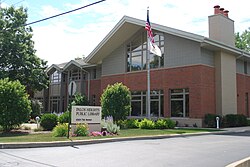2020 census
As of the 2020 census [15] there were 12,068 people, 4,625 households, and 3,407 families residing in the city. The population density was 3,116.74 inhabitants per square mile (1,203.38/km2). There were 5,114 housing units at an average density of 1,320.76 per square mile (509.95/km2). The racial makeup of the city was 90.25% White, 1.91% Asian, 1.67% African American, 0.07% Native American, 1.32% from other races, and 4.78% from two or more races. Hispanic or Latino of any race were 5.35% of the population.
There were 4,625 households, out of which 21.1% had children under the age of 18 living with them, 62.46% were married couples living together, 9.04% had a female householder with no husband present, and 26.34% were non-families. 21.75% of all households were made up of individuals, and 15.16% had someone living alone who was 65 years of age or older. The average household size was 2.98 and the average family size was 2.55.
The city's age distribution consisted of 17.3% under the age of 18, 7.3% from 18 to 24, 19.2% from 25 to 44, 25.7% from 45 to 64, and 30.4% who were 65 years of age or older. The median age was 51.7 years. For every 100 females, there were 99.0 males. For every 100 females age 18 and over, there were 96.8 males.
The median income for a household in the city was $90,995, and the median income for a family was $105,134. Males had a median income of $64,583 versus $44,342 for females. The per capita income for the city was $44,721. About 3.8% of families and 5.7% of the population were below the poverty line, including 8.9% of those under age 18 and 5.3% of those age 65 or over.
Palos Heights city, Illinois – Racial and ethnic composition
Note: the US Census treats Hispanic/Latino as an ethnic category. This table excludes Latinos from the racial categories and assigns them to a separate category. Hispanics/Latinos may be of any race.| Race / Ethnicity (NH = Non-Hispanic) | Pop 2000 [16] | Pop 2010 [13] | Pop 2020 [14] | % 2000 | % 2010 | % 2020 |
|---|
| White alone (NH) | 10,727 | 11,456 | 10,734 | 95.27% | 91.54% | 88.95% |
| Black or African American alone (NH) | 47 | 208 | 196 | 0.42% | 1.66% | 1.62% |
| Native American or Alaska Native alone (NH) | 9 | 6 | 4 | 0.08% | 0.05% | 0.03% |
| Asian alone (NH) | 232 | 249 | 224 | 2.06% | 1.99% | 1.86% |
| Pacific Islander alone (NH) | 0 | 1 | 0 | 0.00% | 0.01% | 0.00% |
| Other race alone (NH) | 6 | 13 | 29 | 0.05% | 0.10% | 0.24% |
| Mixed race or Multiracial (NH) | 78 | 108 | 235 | 0.69% | 0.86% | 1.95% |
| Hispanic or Latino (any race) | 161 | 474 | 646 | 1.43% | 3.79% | 5.35% |
| Total | 11,260 | 12,515 | 12,068 | 100.00% | 100.00% | 100.00% |
2000 census
As of the 2000 census, [17] there were 11,561 people, 4,123 households, and 3,133 families residing in the city. The population density was 2,978.6 people per square mile (1,150.0 people/km2). There were 4,268 housing units at an average density of 1,129.0 per square mile (435.9/km2). The racial makeup of the city was 96.39% White, 0.44% African American, 0.09% Native American, 2.06% Asian, 0.25% from other races, and 0.78% from two or more races. Hispanic or Latino of any race were 1.43% of the population.
The top five ancestries reported in Palos as of the 2000 census were Irish (27.2%), German (20.5%), Polish (14.1%), Italian (10.5%) and Dutch (9.1%). [18]
There were 4,123 households, out of which 25.0% had children under the age of 18 living with them, 67.0% were married couples living together, 6.6% had a female householder with no husband present, and 24.0% were non-families. 22.2% of all households were made up of individuals, and 14.2% had someone living alone who was 65 years of age or older. The average household size was 2.54 and the average family size was 2.98.
In the city, the population was spread out, with 20.2% under the age of 18, 8.2% from 18 to 24, 18.6% from 25 to 44, 27.5% from 45 to 64, and 25.5% who were 65 years of age or older. The median age was 47 years. For every 100 females, there were 86.2 males. For every 100 females age 18 and over, there were 81.8 males.
The median income for a household in the city was $69,907, and the median income for a family was $81,100. Males had a median income of $61,786 versus $37,188 for females. The per capita income for the city was $32,895. About 2.6% of families and 3.2% of the population were below the poverty line, including 4.0% of those under age 18 and 4.1% of those age 65 or over.







